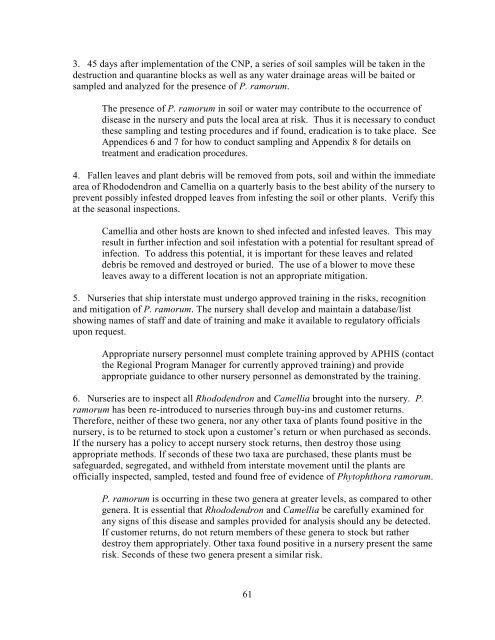Confirmed Nursery Protocol - aphis
Confirmed Nursery Protocol - aphis
Confirmed Nursery Protocol - aphis
You also want an ePaper? Increase the reach of your titles
YUMPU automatically turns print PDFs into web optimized ePapers that Google loves.
3. 45 days after implementation of the CNP, a series of soil samples will be taken in the<br />
destruction and quarantine blocks as well as any water drainage areas will be baited or<br />
sampled and analyzed for the presence of P. ramorum.<br />
The presence of P. ramorum in soil or water may contribute to the occurrence of<br />
disease in the nursery and puts the local area at risk. Thus it is necessary to conduct<br />
these sampling and testing procedures and if found, eradication is to take place. See<br />
Appendices 6 and 7 for how to conduct sampling and Appendix 8 for details on<br />
treatment and eradication procedures.<br />
4. Fallen leaves and plant debris will be removed from pots, soil and within the immediate<br />
area of Rhododendron and Camellia on a quarterly basis to the best ability of the nursery to<br />
prevent possibly infested dropped leaves from infesting the soil or other plants. Verify this<br />
at the seasonal inspections.<br />
Camellia and other hosts are known to shed infected and infested leaves. This may<br />
result in further infection and soil infestation with a potential for resultant spread of<br />
infection. To address this potential, it is important for these leaves and related<br />
debris be removed and destroyed or buried. The use of a blower to move these<br />
leaves away to a different location is not an appropriate mitigation.<br />
5. Nurseries that ship interstate must undergo approved training in the risks, recognition<br />
and mitigation of P. ramorum. The nursery shall develop and maintain a database/list<br />
showing names of staff and date of training and make it available to regulatory officials<br />
upon request.<br />
Appropriate nursery personnel must complete training approved by APHIS (contact<br />
the Regional Program Manager for currently approved training) and provide<br />
appropriate guidance to other nursery personnel as demonstrated by the training.<br />
6. Nurseries are to inspect all Rhododendron and Camellia brought into the nursery. P.<br />
ramorum has been re-introduced to nurseries through buy-ins and customer returns.<br />
Therefore, neither of these two genera, nor any other taxa of plants found positive in the<br />
nursery, is to be returned to stock upon a customer’s return or when purchased as seconds.<br />
If the nursery has a policy to accept nursery stock returns, then destroy those using<br />
appropriate methods. If seconds of these two taxa are purchased, these plants must be<br />
safeguarded, segregated, and withheld from interstate movement until the plants are<br />
officially inspected, sampled, tested and found free of evidence of Phytophthora ramorum.<br />
P. ramorum is occurring in these two genera at greater levels, as compared to other<br />
genera. It is essential that Rhododendron and Camellia be carefully examined for<br />
any signs of this disease and samples provided for analysis should any be detected.<br />
If customer returns, do not return members of these genera to stock but rather<br />
destroy them appropriately. Other taxa found positive in a nursery present the same<br />
risk. Seconds of these two genera present a similar risk.<br />
61
















